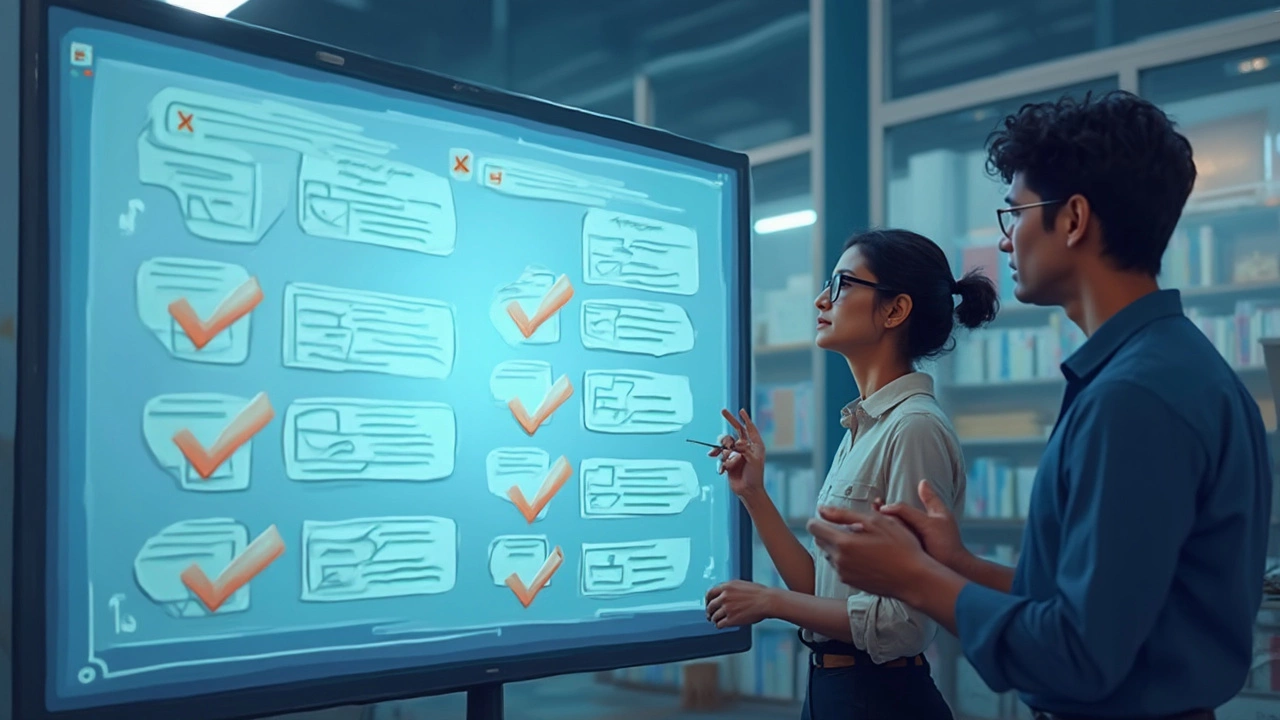You ever get lost in a sea of websites and apps, all promising to teach something new? Not all of them are what you'd call a real eLearning platform. Some are just video sites with fancy packaging. The difference matters, especially if you're looking to actually learn—or help others learn—something useful.
If you want a place where you can track progress, access materials on demand, interact with teachers, and maybe even grab a certificate at the end, that's what sets eLearning platforms apart. Instead of just watching random videos or reading blog posts, you get a proper setup for learning—think structured lessons, quizzes, feedback, and sometimes even classmates to bounce ideas off. It’s more like an online classroom than a pile of unorganized content.
Getting the right platform can save you tons of time and headaches. No more clicking around hoping you’re actually moving forward. Up next, I’ll lay out exactly what makes these platforms tick and how you can spot the real deal next time you’re searching.
- What Exactly Is an eLearning Platform?
- Common Features You’ll Find
- Popular Examples and What Makes Them Stand Out
- How to Pick the Right One for You
What Exactly Is an eLearning Platform?
A eLearning platform is basically the online version of a classroom, but way more flexible. Instead of walking into a building, you log in from your laptop or phone. These platforms organize the whole learning process for you—courses, videos, reading materials, progress checks, and even quizzes—all in one spot.
The big thing that makes something a real online course platform is structure. It's not just a bunch of loose videos or PDFs. Usually, you sign up with an account and get a dashboard showing what you need to do next. You always know where you left off and what’s coming up.
Experts at EdSurge put it this way:
“An eLearning platform is a digital space where instructors can deliver lessons, track student progress, and foster interactive learning, often with tools for quizzes, assignments, and feedback.”
Want to know what usually shows up in these platforms? Here are a few must-haves you’ll see:
- User accounts and profiles—for a personal experience
- Course catalogs—so you can browse and pick what you want to learn
- Interactive lessons—think videos, quizzes, and sometimes even live sessions
- Progress trackers—so you can see how far you’ve come
- Certificates when you finish (on most legit platforms)
To give you an idea of how huge this is, check out this simple stat table:
| Year | Number of eLearning Users Worldwide |
|---|---|
| 2019 | ~300 million |
| 2023 | ~650 million |
That’s double in just four years! Clearly, a lot of people have jumped onto platforms like Coursera, Udemy, and LinkedIn Learning to pick up new skills or even whole degrees without ever stepping into a physical classroom.
Bottom line? If you can enroll in organized courses, track your progress, and even ask questions or talk to a teacher, you’re almost definitely on a eLearning platform. If you’re just watching random videos or scrolling through blogs, you’re probably not.
Common Features You’ll Find
If you poke around any real eLearning platform, you’ll start to notice a pattern. These tools aren’t just dumping a bunch of videos and calling it a day. They’re packed with features that actually make learning stick and keep things organized for everyone involved.
Here’s what you can typically expect to find:
- Progress Tracking: Most solid eLearning platforms show you where you left off and how much you’ve got left to go. There’s usually a dashboard or a progress bar, so you don’t have to guess if you’re halfway done or just getting started.
- Quizzes and Tests: These aren’t just for school kids. They’re everywhere on eLearning sites and help you check if you’re actually learning something. Instant results mean you’re not left wondering.
- Course Structure: Lessons are broken down into modules, sections, or steps. You move forward in order, and there’s a clear path to finish the whole course.
- Certificates: Finished a course? Many platforms toss you a digital certificate. Great for showing off on LinkedIn or your CV—even if it’s just for bragging rights.
- Interactive Content: Look for things like live Q&As, forums, or comment sections. Good online course platforms know that talking to others helps stuff sink in.
- Mobile Access: Most decent platforms have an app, or at least a solid mobile site, so you can keep learning on your own schedule.
- Resource Downloads: Worksheets, slides, extra reading—having these means you can dig deeper when you want.
The big guys aren’t shy with their numbers. According to Class Central, “Over 220 million learners used online learning management systems in 2023.” That’s not just hype; it shows how these features have become standard for a huge crowd of learners.
| Feature | Why It Matters |
|---|---|
| Progress Tracking | Keeps you from feeling lost |
| Quizzes | Checks if the knowledge is sticking |
| Certificates | Shows off new skills to employers |
| Interactive Content | Boosts engagement and networking |
| Mobile Access | Lets you learn anytime, anywhere |
As LinkedIn Learning puts it,
"Self-directed learning should empower learners to set their own pace, but structure and measurable progress keep things from falling apart."So when you’re scouting for the best platform, these features are your checklist. If any of these are missing, you might want to keep looking.

Popular Examples and What Makes Them Stand Out
You hear about eLearning platforms everywhere, but a few names really pop up when folks want something reliable. Let’s break down some big hitters and see what makes each one actually useful—and not just flashy.
- Coursera: Coursera’s a go-to if you want college-level classes from real universities. They team up with big names like Stanford and Google, letting you earn legit certificates or even degrees. They pack in quizzes, community forums, and you can download lessons for offline study. Fun fact: there are over 110 million users worldwide as of 2024.
- Udemy: You know those random skills you always wanted to learn? Udemy probably has a course on it—over 200,000 of them, in fact. Anyone can upload a course, which is both a pro and a con, but filters and reviews help you find good stuff. There’s lifetime access, so you buy once and revisit whenever.
- Khan Academy: It’s free and focused on school-style learning, mostly math, sciences, and SAT prep. Tons of exercises, super clear explanations, and parents can track their kid’s progress. Great for brushing up or filling school gaps without paying a dime.
- LinkedIn Learning: Built for work skills—think project management, coding basics, design programs. Your progress shows up right on your LinkedIn profile, which can get you noticed by recruiters. They release new professional courses every week.
- Moodle: Not as shiny-looking, but super customizable and open-source, so schools or companies can run their own private learning management system. It’s used worldwide by all kinds of organizations, from tiny nonprofits to universities.
Some eLearning platforms stand out by price, others because of content quality or by the credential you get. Here’s a quick glance at their focus:
| Platform | Best For | Certifications | Price |
|---|---|---|---|
| Coursera | College-level courses, degrees | Yes (with some free options) | Free & Paid (average $39/month) |
| Udemy | Quick skills and hobbies | Certificate of completion | One-time payments, often $10-$30 per course |
| Khan Academy | School subjects, test prep | No, but trackable progress | Free |
| LinkedIn Learning | Professional upskilling | Yes, adds to LinkedIn profile | $39.99/month (free trial available) |
| Moodle | Custom school/company courses | Depends on setup | Free/open-source (hosting may cost money) |
So, don’t just look at the name or price—think about what you want to learn, how interactive you want things to be, and if credentials matter to you. That stuff’s what really counts when picking an eLearning platform that won't waste your time.
How to Pick the Right One for You
Alright, so you’ve figured out what a real eLearning platform is. Now comes the million-dollar question: how do you choose the one that actually works for you? There are specific things you can look for—no guesswork or gut feelings needed.
First off, solve for your goal. Are you learning alone, teaching a class, or running a training program? For solo learners, platforms like Coursera and Udemy give you lots of choice and flexibility. If you’re a teacher or business, something like Moodle or TalentLMS puts you in control over what, when, and how people learn.
Let’s break this down:
- Is it easy to use? Try a free trial or test lesson. If you can't figure it out in five minutes, move on. Complicated tools kill motivation fast.
- Does it have the features you actually need? Not every platform has quizzes, discussion forums, or certificates. Double-check before you buy.
- What’s your budget? Some platforms charge by user, others by course or offer free versions for basics. For businesses, costs stack up if you have loads of users. For students or teachers, freebies like Google Classroom might do the job.
- Can you learn on your phone? Over 58% of learners use mobile devices for at least part of their training (according to Statista, 2024). If you want to learn anywhere, pick a platform with a solid app.
- Does it fit your learning style? If you like short videos, Q&A spots, or community chat, check if these exist. Everyone learns a bit differently.
Don’t ignore the reviews—check Reddit, Trustpilot, or even YouTube walkthroughs to see what real users think. Often you’ll find hidden issues you won’t read on the company’s own site.
And a pro tip: try to future-proof. If you think you might need new features down the road (like adding more courses or integrating Zoom), see if those options exist or can be added easily. Alison Lacy, an LMS consultant, puts it simply:
"The best eLearning platform isn’t what’s trending—it’s what fits your goals and can grow with you."
If you want to compare some of the top online course platforms head to head, here’s how they stack up on a few basics:
| Platform | Free Version | Mobile Support | Main Use |
|---|---|---|---|
| Udemy | No (for teachers) | Yes | Self-paced courses |
| Coursera | Limited | Yes | Academic courses |
| Google Classroom | Yes | Yes | School/educators |
| Moodle | Yes (open source) | Yes | Education/enterprise |
Bottom line: don’t get dazzled by fancy features you won’t use. Go for a digital learning platform that checks your personal boxes, not someone else’s wish list.






Write a comment: